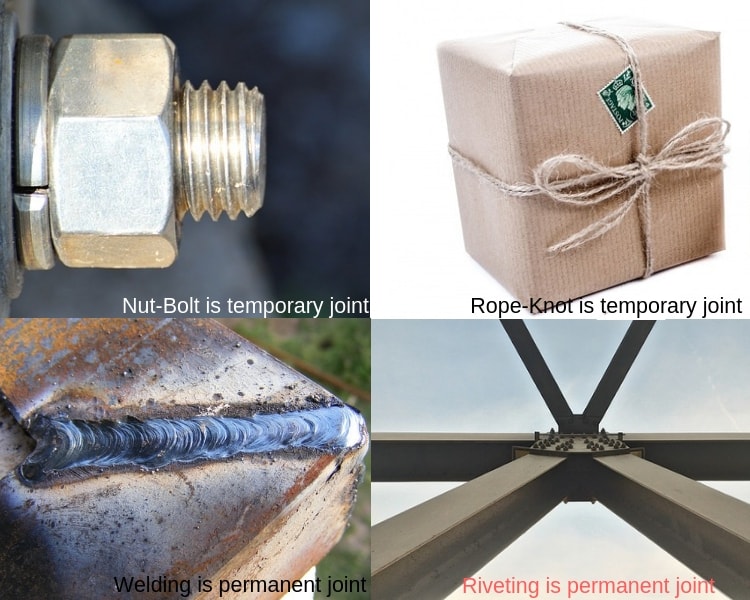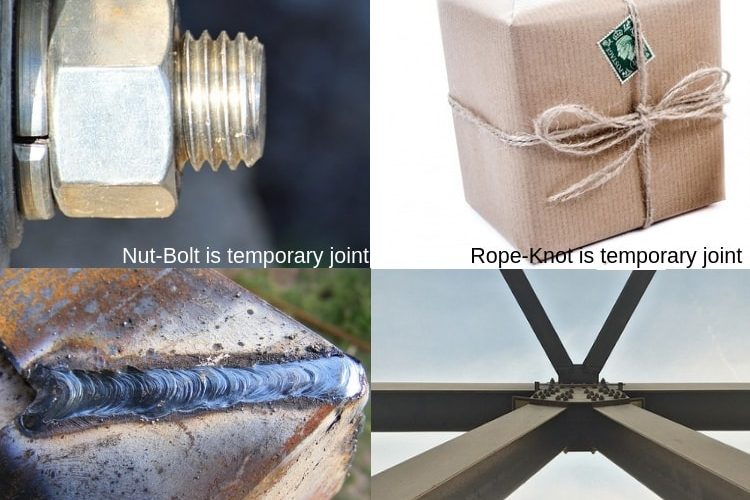Joining is a part and parcel of manufacturing as it facilitates easy and economic production of intricate shaped objects. By definition, joining is one of the manufacturing processes by which two or more solid components can be assembled together to obtain a single unit. As usual a large number of joining processes exists in order to assemble wide variety of materials in multifarious ways that are expected to serve different functionalities. Some of these joining processes can assemble components permanently; while others can assemble temporarily. Accordingly joining processes can be broadly classified into two groups—temporary joining processes and permanent joining processes.
Temporary joining processes are all those joining processes that allow easy dismantling of joined components without rupturing them. It facilitates assembly and disassembly of solid structures as and when required without harming them. All fasteners basically provide temporary joints. Such joining is beneficial for inspection, maintenance and repair purposes as joint can be dismantled easily without breaking parts. However, they are prone to failure under vibration because of loosening of joining elements. Also strength of joint is not very high and thus these processes are not suitable for heavy load applications.
Such problems can be eliminated by utilizing a permanent joining process. By definition, a permanent joint is one that does not allow disassembly of joined components without rupturing them. Welding, riveting, coupling, etc. are common examples of such process. It can provide a sound, reliable, leak-proof and sufficiently strong joint and thus can be safely used for heavy load applications. However, it possesses problem during inspection and maintenance. Various differences between temporary joining and permanent joining are given below in table format.

Table: Differences between temporary joining and permanent joining
| Temporary Joining | Permanent Joining |
|---|---|
| A temporary joint can be dismantled without breaking the assembled parts. | A permanent joint cannot be dismantled without breaking parts. |
| Temporary joining is beneficial where frequent assembly and disassembly are required. | Permanent joining is beneficial where joint is intended to stay fixed for longer period. |
| Strength of temporary joint is comparatively lower. | Permanent joint offers stronger joining. |
| Temporary joints are not leak-proof. | Most permanent joining processes provide leak-proof joints. |
| Temporary joining processes offer easy and cost efficient inspection, repair and maintenance as parts can be dismantled without breaking. | Inspection, repair and maintenance are difficult when structures are joined permanently as disassembly is not possible without breaking. |
Examples of various temporary joining techniques:
|
Examples of various permanent joining techniques:
|
Possibility of dismantling assembled parts: As the name suggests, a temporary joint allow easy and quick disassembly of joined components without breaking them. Contrary to this, permanent joints are intended to stay in fixed position for longer duration. Such joints are permanent in nature and cannot be dismantled without breaking assembled parts.
Suitability: Since temporary joint allows disassembly without damaging parts, so it is preferred where frequent assembly and disassembly are desired. This makes replacing damaged parts easier. Interchangeability is one of the most crucial features offered by this joining. Permanent joining is suitable in those applications that require a strong, reliable and leak-proof joint and at the same time the joint is expected to stay in assembled condition for longer duration; for example window frame.
Strength of joint: Most temporary joining processes provide weaker joint that cannot bear higher load under service condition. Usually joining strength is considered to be lower than that of the parent components. Permanent joining processes usually provide sound, reliable and stronger joint. Joint strength is comparable with the strength of parent components and mostly these are equal.
Leak-proof joining: Permanent joining processes, if carried out properly using optimum process parameters, can provide leak-proof joints. This feature is very useful in many applications including pipe joining, pressure vessel joining, joining of structural parts that are intended to stay within water as in case of ships, etc. However, the capability of sustaining pressure or force during service life varies greatly on different factors including joining process employed. Temporary joining processes do not usually provide leak-proof joints.
Biggest advantage of temporary joint: Since assembled parts can be dismantled without breaking them, so inspection, repair and maintenance are easier and at the same time cost and time efficient. Non-destructive testing (NDT) can be employed for inspection purposes. So no parts get damaged during testing or maintenance service. No permanent joint offers this advantage and thus destructive testing method is frequently employed for inspection and maintenance purposes. So parts get damaged and thus scrap rate increases and as a consequence overall cost of production also increases.
Examples of these joining processes: Fasteners are the fast and foremost example for temporary joints. It includes, but not limited to, threaded elements like nut, bolt, screw, etc., clips, buttons, clamps, cables, nails, hooks, rings, bands, staples, etc. Apart from fasteners, joining by press fit, cotter joint, knuckle joint, etc. are also temporary joining elements. On the other hand, welding is one overwhelmingly accepted permanent joining process. Except this, rivet joint, coupling, soldering, brazing, etc. are considered as permanent joining processes. Most adhesive bonding also affix parts permanently.
Scientific comparison among temporary joining and permanent joining is presented in this article. The author also suggests you to go through the following references for better understanding of the topic.
- Difference Between Temporary Joint and Permanent Joint by difference.minaprem.com.


